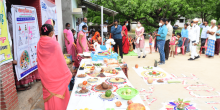Food choice in transition: Adolescent autonomy agency and the food environment

Background: Anemia control programs in India focus mainly on the measurement of hemoglobin in response to iron–folic acid supplementation. However, representative national estimates of iron deficiency (ID) are not available.
Objectives: The objective of the present study was to evaluate ID prevalence among children and adolescents (1–19 y) using nationally representative data and to examine the sociodemographic patterning of ID.
Methods: Cross-sectional data from the Comprehensive National Nutrition Survey in children (1–4 y: n = 9635; 5–9 y: n = 11,938) and adolescents (10–19 y; n = 11,507) on serumferritin (SF) and other biomarkerswere analyzed to determine inflammation-adjusted ID prevalence [SF (μg/L): <12 in 1–4 y and <15 in 5–19 y] and its relation to sociodemographic indicators. Multiple-regression analyses were conducted to identify the exposure associations of iron status. In addition, the relation between SF and hemoglobin was assessed as an indicator of iron utilization in different wealth quintiles.
Results: ID prevalence was higher in 1- to 4-y-old children (31.9%; 95% CI: 31.0%, 32.8%) and adolescent girls (30.4%; 95% CI: 29.3%, 31.5%) but lower in adolescent boys and 5- to 9-y-old children (11%–15%). In all age groups, ID prevalence was higher in urban than in rural participants (1–4 y: 41% compared with 29%) and in those from richer quintiles (1–4 y: 44% in richest compared with 22% in poorest), despite adjustment for relevant confounders. SF significantly interacted with the wealth index, with declining trends in the strength of association between hemoglobin and SF from the richest to the poorest groups suggesting impaired iron utilization for hemoglobin synthesis in poorer wealth quintiles.
Conclusions: ID prevalence was indicative of moderate (in preschool children and adolescent girls) or mild (in 5- to 9-yold children and adolescent boys) public health problem with significant variation by state and age. Focusing on increasing iron intake alone, without addressing themultiple environmental constraints related to poverty,may not result in intended benefits.


